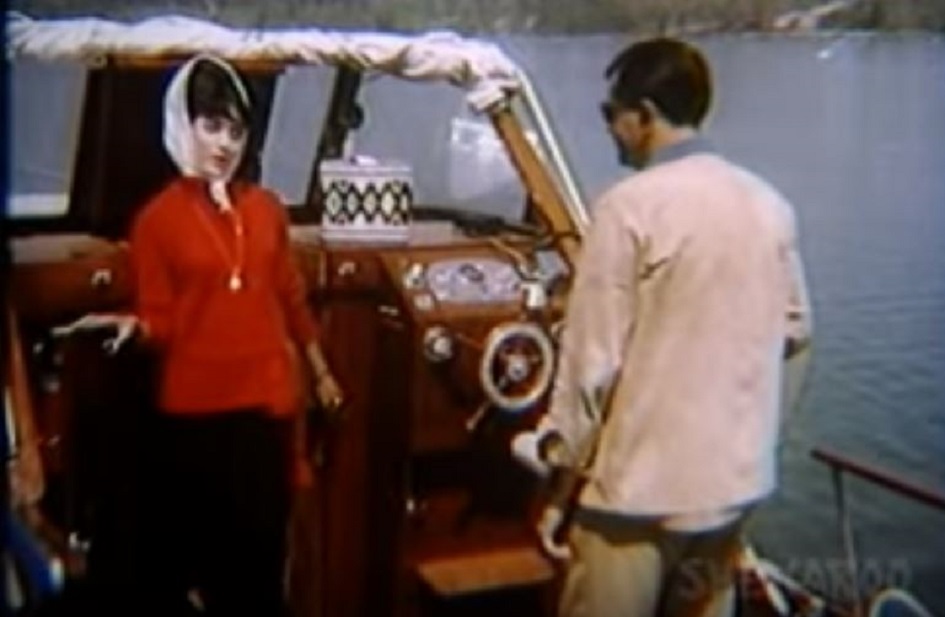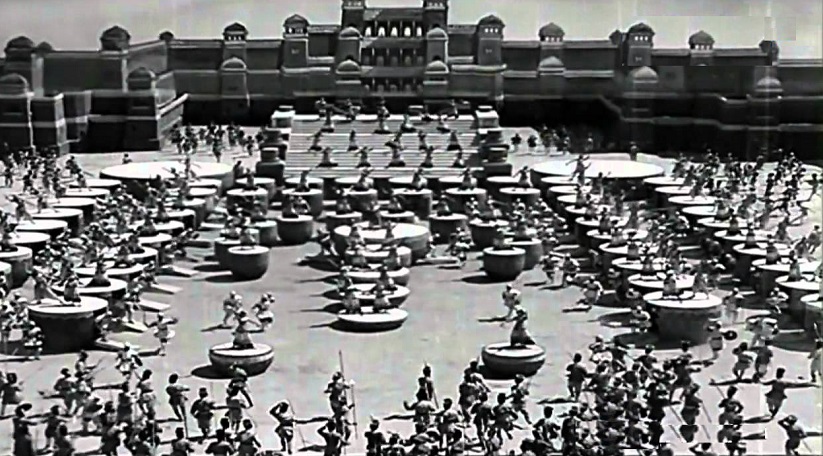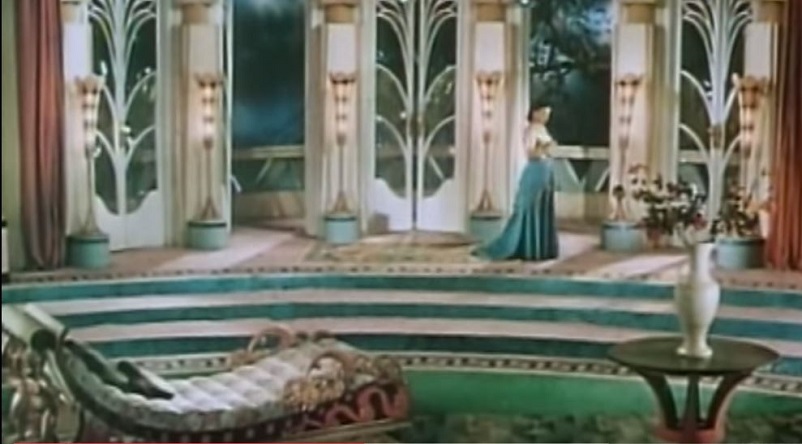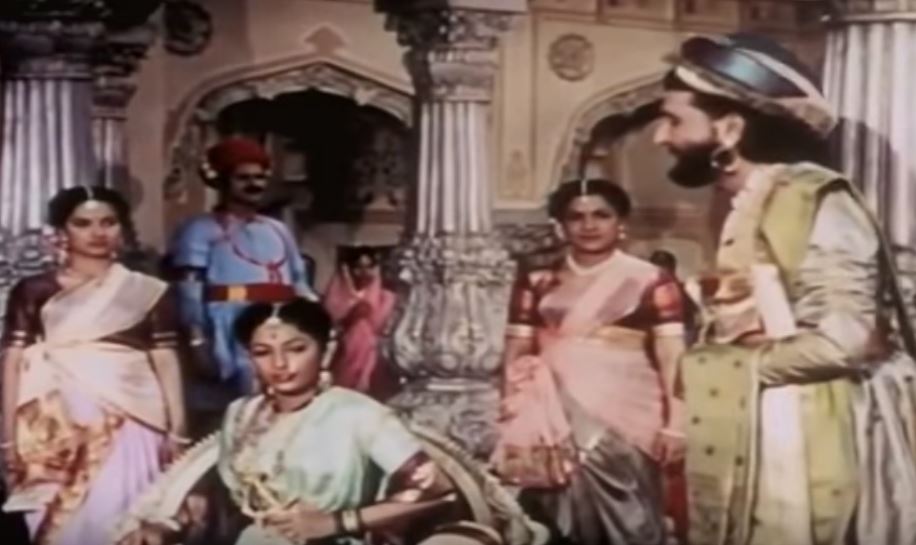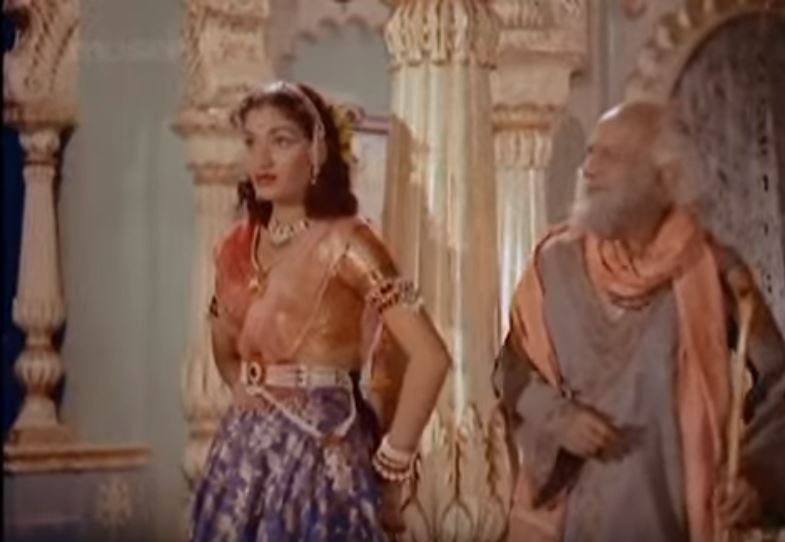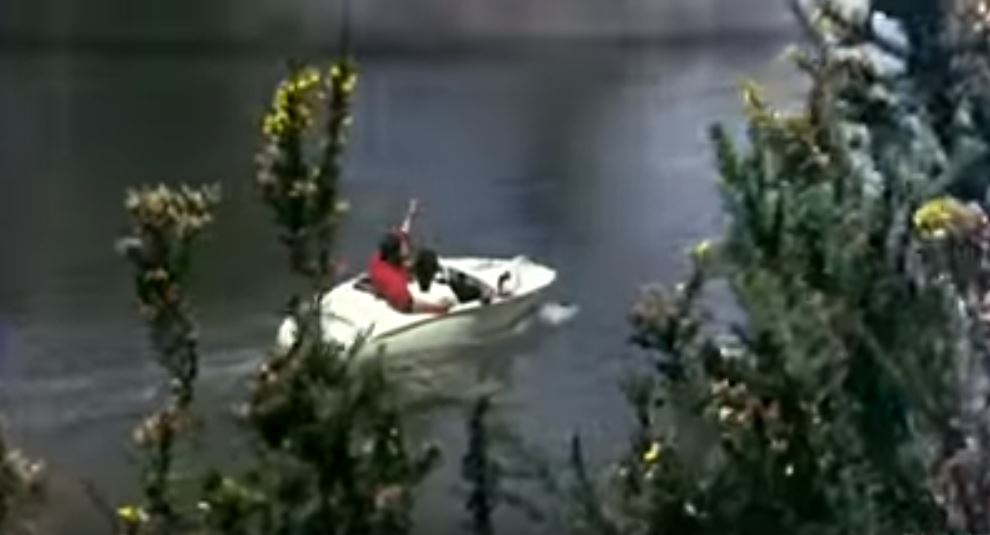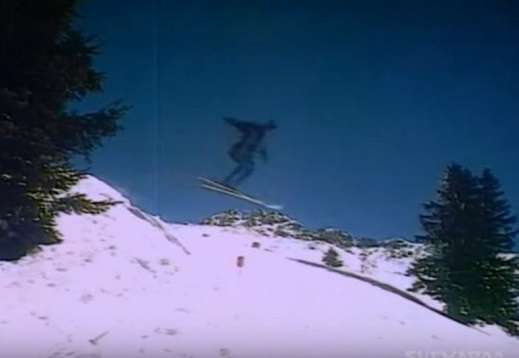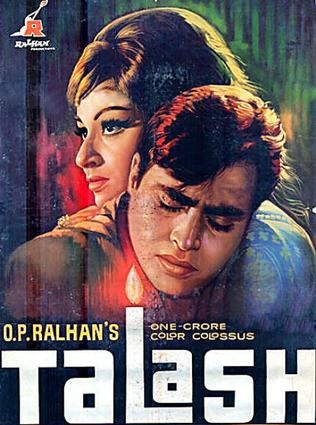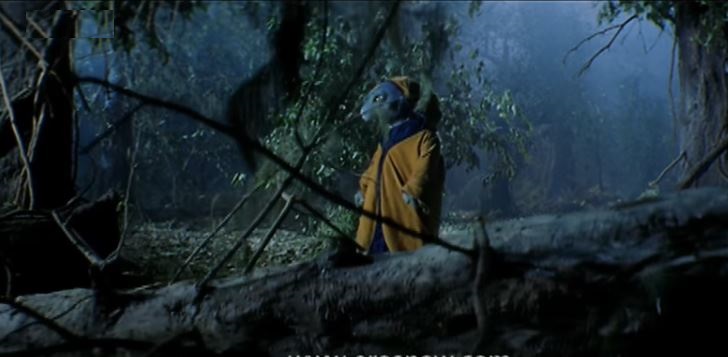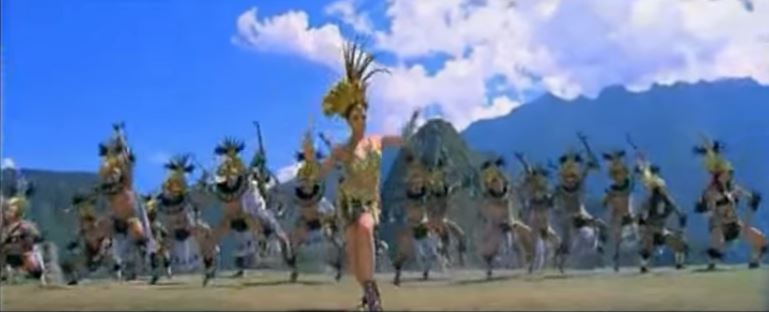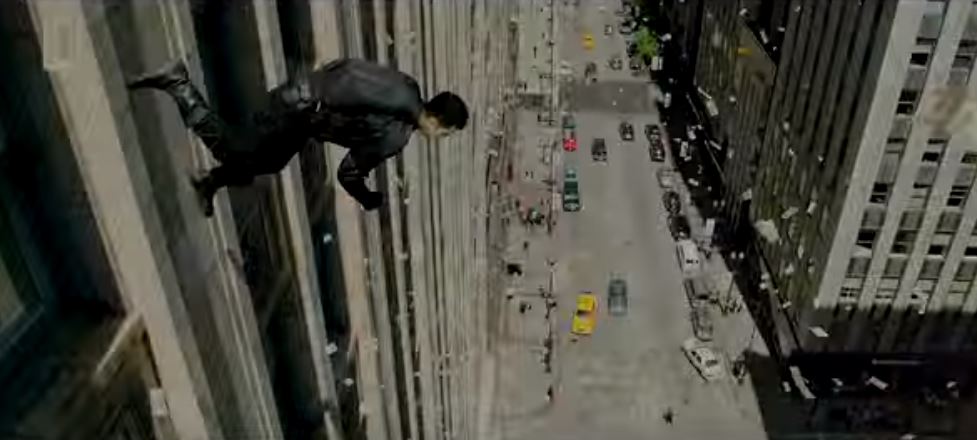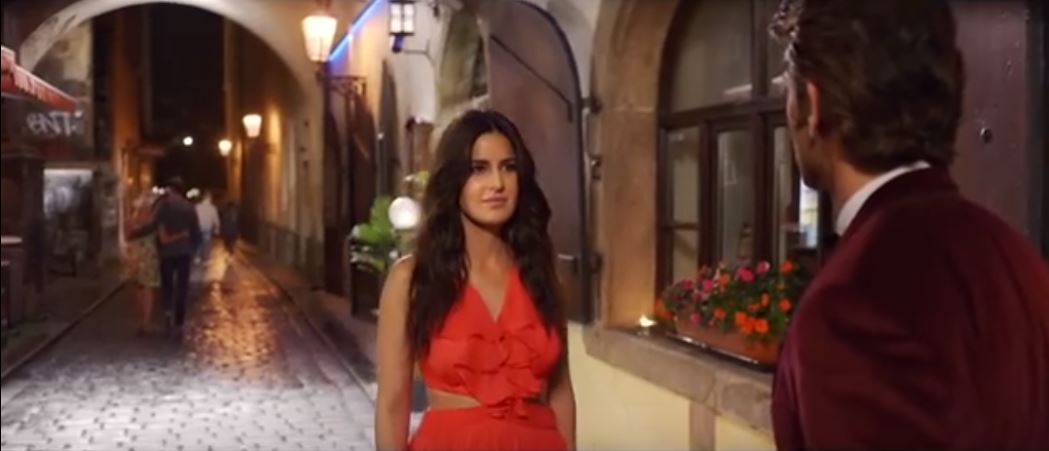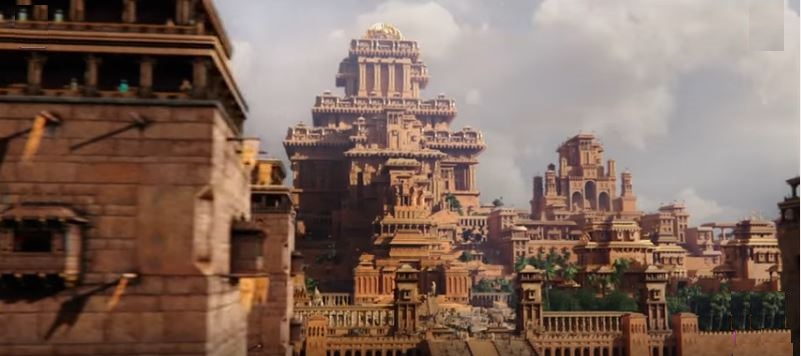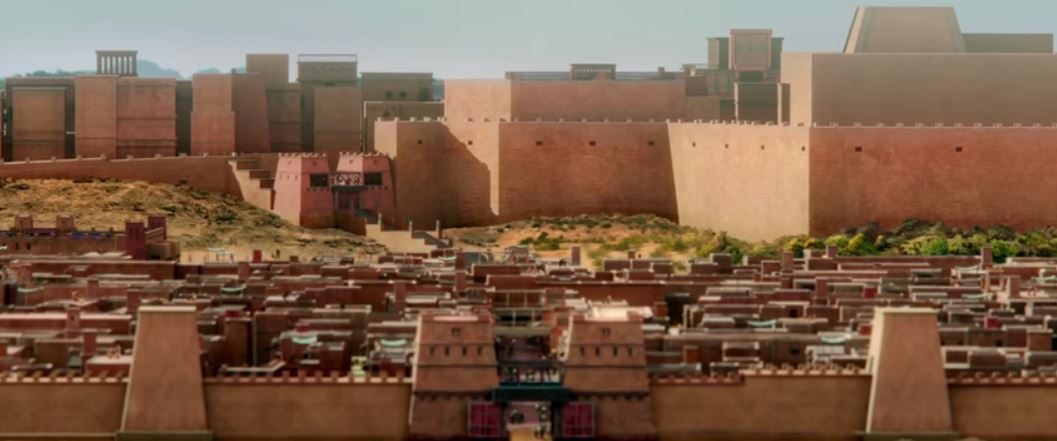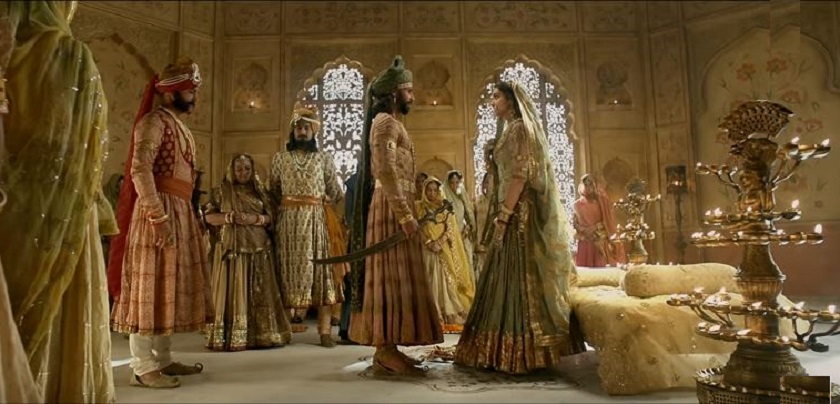The most expensive Hindi-Urdu films
(→See also) |
(→2014) |
||
| (8 intermediate revisions by one user not shown) | |||
| Line 1: | Line 1: | ||
| − | [[File: Madhubala in the ultra-expensive song ‘Prem jogan ban-ke’ from ''Mughal-E-Azam ''.jpg| [[Madhubala, actress]], in the ultra-expensive song ‘Prem jogan ban-ke’ from ''Mughal-e-Azam '' |frame|500px]] | + | [[File: Madhubala in the ultra-expensive song ‘Prem jogan ban-ke’ from ''Mughal-E-Azam ''1.jpg| [[Madhubala, actress]], in the ultra-expensive song ‘Prem jogan ban-ke’ from ''Mughal-e-Azam '' |frame|500px]] |
[[File: LOC Kargil.jpg| Just as the US Army lets Hollywood war dramas photograph actual equipment, the Indian Army allowed the makers of the patriotic epic '' LOC: Kargil '' (2003) to photograph real tanks and locations. If the film’s producers had to make scale models of those guns the cost of '' LOC: Kargil '' would have been higher still. |frame|500px]] | [[File: LOC Kargil.jpg| Just as the US Army lets Hollywood war dramas photograph actual equipment, the Indian Army allowed the makers of the patriotic epic '' LOC: Kargil '' (2003) to photograph real tanks and locations. If the film’s producers had to make scale models of those guns the cost of '' LOC: Kargil '' would have been higher still. |frame|500px]] | ||
| Line 56: | Line 56: | ||
===1951 === | ===1951 === | ||
'''Aan''' | '''Aan''' | ||
| − | [[File: Aan most expensive film of its | + | [[File: Aan most expensive film of its time1.jpg| '' Aan '' was India’s second film in colour and had ‘prints in Technicolor.’ |frame|500px]] |
Box office rank that year: 1. | Box office rank that year: 1. | ||
The money was spent on Kodak negative, Technicolor print, lavish sets and costumes. Dilip Kumar would not have been very expensive then. | The money was spent on Kodak negative, Technicolor print, lavish sets and costumes. Dilip Kumar would not have been very expensive then. | ||
| + | |||
===195?=== | ===195?=== | ||
Jhansi ki Rani | Jhansi ki Rani | ||
| Line 446: | Line 447: | ||
==2014== | ==2014== | ||
'''Bang Bang ''' (2014): | '''Bang Bang ''' (2014): | ||
| − | [[File: Bang Bang most expensive film of its time.jpg| '' Bang Bang!'' was India’s second film in IMAX. Being the official remake of a Hollywood hit (as opposed to | + | [[File: Bang Bang most expensive film of its time.jpg| '' Bang Bang!'' was India’s second film in IMAX. Being the official remake of a Hollywood hit (as opposed to plagiarised versions) would have cost a petty penny in purchasing the rights.|frame|500px]] |
It took Rs 140 crore to remake the Tom Cruise and Cameron Diaz-starrer film Knight and Day. As two of the highest paid Bollywood actors, Hrithik Roshan and Katrina Kaif, united for the action-packed flick, things were expected to be huge in every way. The filmmakers roped in Andy Armstrong (Hollywood action director who has worked on The Amazing Spiderman 2) to deliver the breathtaking and death defying stunts. Also, the action sequences involved Hrithik driving an F1 car, water-skiing while being tied to a sea-plane and doing the fly board stunts. As if this was not enough to make it grand, the film was widely shot at locations in Prague, US, Thailand and Greece. | It took Rs 140 crore to remake the Tom Cruise and Cameron Diaz-starrer film Knight and Day. As two of the highest paid Bollywood actors, Hrithik Roshan and Katrina Kaif, united for the action-packed flick, things were expected to be huge in every way. The filmmakers roped in Andy Armstrong (Hollywood action director who has worked on The Amazing Spiderman 2) to deliver the breathtaking and death defying stunts. Also, the action sequences involved Hrithik driving an F1 car, water-skiing while being tied to a sea-plane and doing the fly board stunts. As if this was not enough to make it grand, the film was widely shot at locations in Prague, US, Thailand and Greece. | ||
| Line 453: | Line 454: | ||
The money was spent on IMAX prints and the things listed by Ruchi Kaushal above. | The money was spent on IMAX prints and the things listed by Ruchi Kaushal above. | ||
| + | |||
| + | [[Category:Pages with broken file links|THE MOST EXPENSIVE HINDI-URDU FILMS]] | ||
==2015== | ==2015== | ||
| Line 499: | Line 502: | ||
[[Bahubali 2: The Conclusion (2017)]] was India’s 3rd IMAX film and was released on 66 screens—India’s biggest IMAX release till then. | [[Bahubali 2: The Conclusion (2017)]] was India’s 3rd IMAX film and was released on 66 screens—India’s biggest IMAX release till then. | ||
| + | |||
| + | It was the most profitable and biggest earning film of 2017. (However, [[Dangal/ 摔跤吧!爸爸 ]], a film released in the last week of 2016, came up from behind, did record business in China and Taiwan, and earned more worldwide than Bahubali 2 both in absolute terms and in terms of return on investment. Bahubali 2 remains India’s no. 1 film at the domestic box office, though.) | ||
2hr48m (168 minutes) | 2hr48m (168 minutes) | ||
| − | == | + | The budget of ''Tiger Zinda Hai,'' the year’s other big film, is generally accepted as Rs150 crore [http://www.koimoi.com/box-office/profitable-films/best-of-2017/ KoiMoi.com] It was the second biggest box office hit of 2017 (i.e. in absolute terms), and the no.13 film most profitable of the year (i.e. in terms of return on investment). |
| − | ''' The article archived below is about big-, not mega-, budget films and mostly covers the period 2007-17 ''' | + | |
| + | ==2018== | ||
| + | [[File: Padmavat most expensive film.jpg|[[Padmaavat, the film]] |frame|500px]] | ||
| + | [[Padmaavat, the film]], a period film and costume drama, cost around Rs.180 crore.([https://www.ndtv.com/entertainment/padmaavat-box-office-collection-day-5-deepika-padukones-film-passes-monday-test-129-crore-and-counti-1806449 NDTV]) It was released in 54 IMAX theatres in 3D, being the first Indian film in IMAX 3D. In addition to 12 IMAX theatres in India, it was also distributed to an 42 IMAX theatres in 10 markets outside of India, including North America, Australia, the Middle East, Africa and the UK. | ||
| + | |||
| + | =Big budget flops= | ||
| + | ==2007-17== | ||
| + | ''' The article archived below is about big-, not mega-, budget films and mostly covers the period 2007-17 ''' | ||
| + | |||
[http://www.misskyra.com/celebs/10-big-budget-bollywood-movies-that-didnt-do-well-at-the-box-office/Saawariya/photostory/62721635.cms Snehha Suresh | 10 Big budget Bollywood movies that didn’t do well at the box-office |January 31, 2018 | '' Miss Kyra '' ] | [http://www.misskyra.com/celebs/10-big-budget-bollywood-movies-that-didnt-do-well-at-the-box-office/Saawariya/photostory/62721635.cms Snehha Suresh | 10 Big budget Bollywood movies that didn’t do well at the box-office |January 31, 2018 | '' Miss Kyra '' ] | ||
| Line 645: | Line 658: | ||
[[Hindi-Urdu films: 2015]] <> | [[Hindi-Urdu films: 2015]] <> | ||
[[Hindi-Urdu films: 2016]] <> | [[Hindi-Urdu films: 2016]] <> | ||
| − | + | [[Hindi-Urdu films: 2017]]... | |
==And also== | ==And also== | ||
[[Box office records of Malayalam films]] 1980-2016, quite detailed | [[Box office records of Malayalam films]] 1980-2016, quite detailed | ||
Revision as of 15:33, 26 September 2021
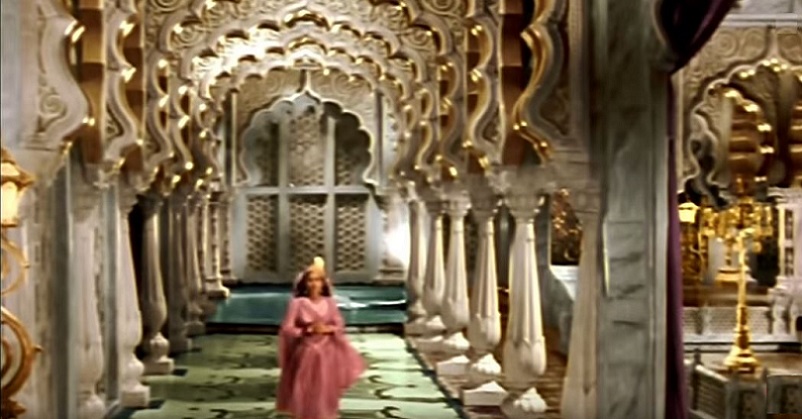
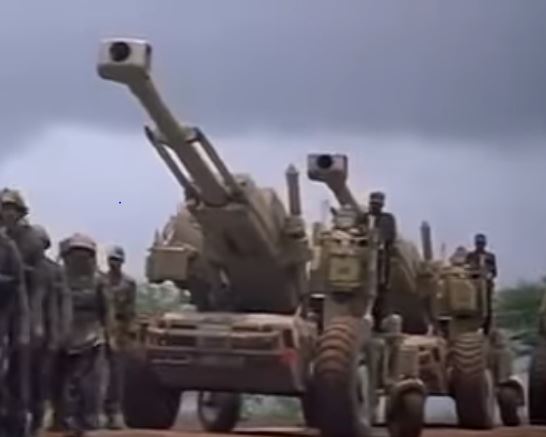
This is a collection of articles archived for the excellence of their content. |
Contents |
The most expensive films
Note of caution: Some middle-aged people (including some actresses) have three sets of ages: their true age, the age they pretend to be and an age higher than the actual (in order to claim senior citizen benefits). Please see Private lives of Indian (Mumbai) stars for the ages claimed by Rekha and Dimple Kapadia when they joined the films.
Before the courts Smt. Dimple Kapadia must have claimed an age higher than the one given to the media. If she did not do so then how was her marriage to Mr Khanna legal? Under the law it would have been a child marriage and thus null and void.
Similarly, most Hindi-Urdu films have three budgets: the actual budget, the figure ‘leaked’ to the media, and the much lower figure given to the tax authorities.
1913 to 2009
In every year there are a few films with budgets that are somewhat bigger than those of the other films of that year. However,from Raja Harischandra (1913) to 2009, once in every five or ten or fifteen years there used to be one spectacle-filled film with a budget very considerably higher than the norm till then: a budget that would not be equalled in the next five or ten years. Mughal-e-Azam (1960) was followed by Sholay (1975). Sangam (1964), too, was a ‘big-budget’ but actual cash investment was not that high because, being the film’s producer, the director and leading man did not have to be paid in advance.
Hindi-Urdu audiences had eagerly waited for years for Around the World (1967) and Mera Naam Joker (1970), both many years in the making, to be released. Both had bigger budgets than Mughal-e-Azam, even after accounting for inflation. ‘Spectaculars’ normally are box-office blockbusters. It was not so with these two films. ATW at least reached the no.11 spot in the box office rankings of that year, meaning that it was an above average earner, though not as big as its huge budget warranted. Joker could not find a place in the Top 23 films of its year; statistics are not available for below that rank.
After 2010
Koi Mil Gaya (2003) and Endhiran (Robot) (2010) set the current mega-budget trend. Both films used expensive, computer-generated images. Even after adjusting for inflation, the budgets of the mega-budget films released after 2010 have reached new heights. (The cash invested in Koi Mil Gaya was less than in Robot, because the director and leading man of KMG were in-house.)
Rs.1 crore in 1970 (Talash, Prem Pujari, Mera Naam Joker) are equal to roughly Rs.55 crore in 2015. However, each part of Bahubali cost around Rs.125 crore, and many Hindi-Urdu films made after 2010 around Rs.115 crore each.
Such a huge jump in budgets has become possible because
i) multiplex ticket prices (say, Rs.350 in Delhi) in 2015 were slightly higher than in the 1960s and ’70s (Rs.6.50 in 1980);
ii) the population has almost doubled, and
iii) so has the size of the middle-class as a percentage of the country’s population.
iv) Dubbing has enabled Hindi-Urdu films to reach the Tamil hinterland (assuming that the two Telugu states, called ‘Nizam’ by film distributors, have always been fairly conversant with Hindi-Urdu) . Conversely, the Tamil Endhiran (Robot), which set the big budget trend, earned almost Rs.20 crore, and the Telugu Bahubali (Part 1 alone) around Rs.120 crore from their Hindi-Urdu versions.
v) The overseas market now accounts for around a quarter??? of the total revenues of commercial as well as ‘multiplex’ (formerly called ‘art’) films. Dhoom 3 was seen in Imax in 23? countries; as with Bahubali, many of these overseas audiences were not of Indian-Pakistani origin.
Therefore, since 2010 the wait for the next record budget has got reduced to a year, sometimes less.
Mega-budget films before 2010
1948
Chandralekha
Box office rank that year: 2.
The money was spent on spectacle, including a famous drum dance. Epic lengths normally hike up the cost of costume dramas (unless costumes and sets are repeated or prolonged). At 3hrs 27 mts/ 207 minutes, Chandralekha is the 22nd longest Hindi-Urdu film ever.
1951
Aan
Box office rank that year: 1.
The money was spent on Kodak negative, Technicolor print, lavish sets and costumes. Dilip Kumar would not have been very expensive then.
195?
Jhansi ki Rani
Box office rank that year: Not in the top ten. A flop.
The money was spent on colour negative, Technicolor print, lavish sets and costumes, war scenes and an English version. The film had no stars other than the heroine.
1955
Jhanak Jhanak Payal Baje
Box office rank that year: 3.
The money was spent on coulur negative, Technicolor print, lavish sets and costumes. The film had no stars.
1957
Mother India
Box office rank that year: 1.
The money was spent on Gevacolour negative, Technicolor print, setting up avillage to recreate poverty and the film’s epic length ?. There was a huge starcast headed by the reigning no.1, Nargis. The three leadng men and the two other leading ladies were not very big stars then.
1960
Box office rank that year: 1.
The money was spent on everything. Recreating Mughal palaces, especially the sheesh mahal (hall of mirrors) and the peacock throne, is infinitely more expensive than depicting poverty (which does not come free either); a substantial Technicolor portion; war scenes; Dilip Kumar was the highest paid star of the era, music director Naushad? the highest paid music director; and Madhubala was at the peak of her career. (LIFE magazine felt that Madhubala, actress was the world's biggest star at the time. This link will take you to the original LIFE article.)
The film had an epic length (3 hours, 11 minues); and obscene payments were made to artistes like the legendary Bade Ghulam Ali Khan? (see Binaca Geet Mala 1960: greatest hits).
Director K. Asif paid the classical maestro Ustad Bade Ghulam Ali Khan Rs25,000 per song to sing ‘Prem jogan ban-ke’ and ‘Shubh din aayo raj dulara’, for his magnum opus Mughal-e-Azam at a time when ‘reigning playback singers like Lata Mangeshkar and Mohammed Rafi got less than Rs500 per song.’
As a result of extravagances like these the film’s costs exceeded its planned budget wildly, delaying its production and release by several years. Shapoorji Pallonji’s investment arm, Sterling, stepped in, acquired the film's rights, and got it completed. (Because they, and not some techno-myopic film producer owner the rights, the Pallonji family got the film colorised in 2004 and made into a stage musical in 2017.)
As could have been predicted in advance, Prem Jogan and Shubh din turned out to be the film’s least popular, least commercially successful songs. Asif could not care less.
For connoisseurs ‘Prem jogan ban-ke’ and ‘Shubh din aayo raj dulara’ are regarded as high points in the history of Indian film music.
191 mts/ 3hrs 11 mts (The colorised version is shorter)
1964
Sangam
Box office rank that year: 1.
The money was spent on Technicolor; shooting in Paris and Switzerland (Sangam was the first Indian film shot abroad); Rajendra Kumar was a ‘jubilee star’ by then, though he would not have overtaken Dilip Kumar when he was signed; and a German-English song was sung by a European singer (hiring Western talent was also a first for India). At 231 minutes (3hours, 51 minutes) Sangam was the first Indian film with two Intervals (an idea popularised by epics like The Ten Commandments) and the fourth longest Hindi-Urdu film ever made.
1965
Waqt
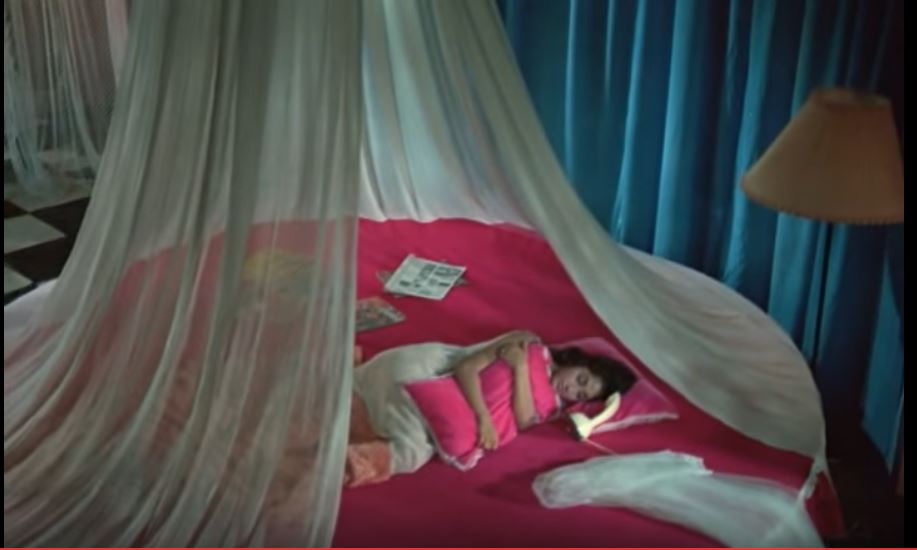
The rich have periodically been with us {since at least Kaagaz ke Phool (1959)}. However, with circular beds, telephones with circular bases, and fancy cars, Waqt was one of the first Indian films to unapologetically celebrate the lives of India’s modern (as opposed to feudal) upper class.
Box office rank that year: 1.
The money was spent on a huge star cast: it had three leading men and two leading ladies. Sadhana, actress might possibly have been the no.1 star of the time; the others were important but not megastars At 3hrs and 26 mts Waqt is the 23rd longest Hindi-Urdu film ever.
1967
Around The World
Box office rank that year: 11.
The money was spent on 70mm and stereophonic sound (for four prints), Technicolor; shooting in many countries; the ship sequence, the skiing sequence and the aeroplane take off were firsts for India; Raj Kapoor would have been very expensive when signed; this was the first Indian film to use a 150-piece orchestra for one of its songs (the title track); the film featured the world’s greatest (West Indian) cricket players of its era.
1969
In the late 1960s three films were launched with budgets that, for the first time in Indian history, reportedly exceeded Rs. 1 crore: Mera Naam Joker, Prem Pujari and Talash. All three had leading men past their prime (though Dev Anand would begin a second innings very soon thereafter) and all three films flopped. The Rs. 1 crore figure was so unprecedented in those days that Talash billed itself in all its advertising as the ‘one crore color colossus.’ The ‘colour’ bit was for alliteration because by 1966 all films in the Top 10 had been in colour.
Talash
Box office rank that year: 15, i.e. just below average.
The money was spent on ??? (goodness knows what). However, Rajendra Kumar was reportedly charging Rs.17 lakh per film by then.
192 mts/ 3hrs 12 mts
1970
Prem Pujari
Box office rank that year: 21, i.e. a major flop.
The money was spent on ??? Much of the film was shot abroad and had very authentic looking props, e.g. the gun Dev Anand posed with in some of the advertising.
191 mts/ 3hrs 11 mts
Mera Naam Joker
Box office rank that year: not in the Top 23; a major disaster.
The money was spent on many things: a humungous—and unwieldy—cast (though few would have charged Raj Kapoor their going rate), Technicolour, some shooting in the USSR, getting the Russian circus to India, epic length…
(254 minutes/ 4 hours and 14 mts: the second longest Hindi-Urdu film. The longest, Tamas, 297 minutes, was really made for six television instalments but also put together for theatres)
1975
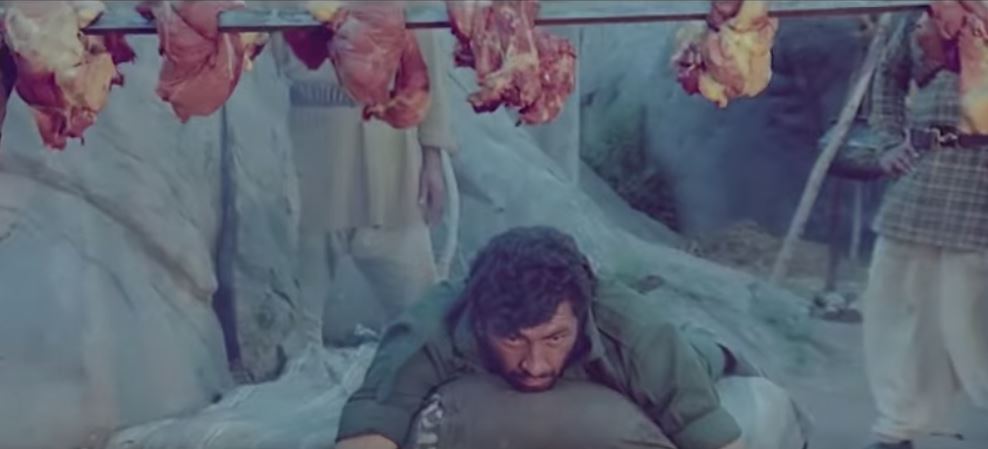
Box office rank that year: 1.
The money was spent on
i) A huge starcast of then current superstars (Waqt had five major stars, none was a superstar; Sholay featured the highest and second highest paid [no. 1 by the time the film was released] male stars of the day, the highest paid female star, the no.1 male and female leading actors in the opinion of critics and in terms of awards, B list leading men like Sachin in minor roles…The actor whom the film revolved around and who propelled the film to historic success was a newcomer who would not have cost much, though after Sholay he became India’s highest paid villain.
ii) 70mm and stereophonic sound (initially for four prints)
iii) The highest paid screenwriters in Indian film history
iv) Recreating a village and a dacoits’ den in rocky territory in Karnataka
v) Epic length (3 hours and 19 minutes; an eight minutes longer version—207? minutes—is available on DVD)
1981
Kranti
Box office rank that year: 2.
The money was spent on 70mm (some prints), epic length, sets (including an 1800s- style ship), a very big cast, the highest paid screenwriters…
Three hours and six minutes/ 186 mts
1993
Roop Ki Rani Choron Ka Raja
Box office rank that year: 14.
The money was spent on ??? The film’s budgetwas supposed to have crossed the Rs 10 crore mark.
2003
Koi Mil Gaya
Box office rank that year: 1.
The money was spent on special effects to rival Spielberg’s E.T. (and ‘inspired by’ E.T.) The film’s publicity did not make a song and dance about the budget because the hero and director were in-house.
LOC Kargil
Box office rank that year: 7, which was very poor considering that with a better script this could have been an all-time blockbuster, much bigger than the same director’s mega-hit Border.
The money was spent on a cast that was even more humungous, but slightly better utilised, than Mera Naam Joker’s. The Indian Army helped out with spectacular locations and props which, if paid for, would have made this 247 minute film (the 3rd longest in Hindi-Urdu film history to date) India’s most expensive ever.
An 8 hour and 13 minute (all right, we are exaggerating slightly; actually it is only 8:12:40) version of LOC: Kargil can be seen on YouTube.
2006
Krrish
Box office rank that year: 2.
The money was spent on special effects: original ideas this time. Though done by Australian experts, their imaginativeness put India behind only Hollywood.
The biggest budgets, 2008- Jan 2017
The budgets mentioned after the name of each film are on the authority of Box Office India
Prem Ratan Dhan Payo ₹180 crore
Dhoom 3 ₹175 crore
Dilwale ₹165 crore
Bang Bang ₹160 crore
Happy New Year ₹150 crore
Sultan ₹145 crore
Bajirao Mastani ₹145 crore
Kick ₹140 crore
Mohenjo Daro ₹138 crore
PK ₹135 crore
Dangal ₹132 crore
Ra.One ₹130 crore
Raees ₹127 crore
Bajrangi Bhaijaan ₹125 crore
Fan ₹120 crore
Bombay Velvet ₹118 crore
Chennai Express ₹115 crore
Brothers ₹112 crore
M.S. Dhoni - The Untold Story ₹110 crore
Welcome Back ₹108 crore
Singham Returns ₹105 crore
Shivaay ₹103 crore
Jai Ho ₹102 crore
Once Upon A Time In Mumbaai Dobaara! ₹100 crore
Ae Dil Hai Mushkil ₹98 crore
Housefull 3 ₹97 crore
Krrish 3 ₹95 crore
Action Jackson ₹93 crore
Ek Tha Tiger ₹92 crore
Singh Is Bling ₹91 crore
Race 2 ₹90 crore
Kaabil ₹89 crore
Goliyon Ki Raasleela Ram - Leela ₹88 crore
Tamasha ₹87 crore
Holiday - A Soldier Is Never Off Duty ₹86 crore
My Name Is Khan ₹85 crore
Dabangg 2 ₹84 crore
Jolly LLB 2 ₹83 crore
Dil Dhadakne Do ₹83 crore
Besharam ₹83 crore
Kites ₹82 crore
Entertainment ₹81 crore
Blue ₹80 crore
Gabbar Is Back ₹79 crore
Jab Tak Hai Jaan ₹78 crore
3 Idiots ₹77 crore
Rowdy Rathore ₹77 crore
Don 2 ₹76 crore
Yeh Jawaani Hai Deewani ₹75 crore
Baby ₹75 crore
Guzaarish ₹74 crore
Rustom ₹73 crore
Satyagraha ₹73 crore
Housefull 2 ₹72 crore
Phantom ₹72 crore
Agneepath ₹71 crore
Talaash ₹71 crore
Fitoor ₹71 crore
Bodyguard ₹70 crore
Befikre ₹70 crore
Boss ₹70 crore
Shaandaar ₹69 crore
Airlift ₹68 crore
Himmatwala ₹68 crore
Son Of Sardaar ₹67 crore
Bol Bachchan ₹66 crore
Rockstar ₹66 crore
ABCD 2 ₹65 crore
Kambakkht Ishq ₹65 crore
Humshakals ₹64 crore
Khiladi 786 ₹63 crore
Veer ₹63 crore
London Dreams ₹63 crore
Mirzya ₹63 crore
Drishyam ₹62 crore
Chandni Chowk To China ₹62 crore
Ready ₹61 crore
Raajneeti ₹61 crore
Dishoom ₹61 crore
Thank You ₹61 crore
Rangoon ₹61 crore
Zindagi Na Milegi Dobara ₹60 crore
De Dana Dan ₹60 crore
Agent Vinod ₹60 crore
Zanjeer ₹60 crore
Broken Horses ₹60 crore
Student Of The Year ₹59 crore
R... Rajkumar ₹58 crore
Happy Ending ₹57 crore
Love Aaj Kal ₹56 crore
Jodhaa Akbar (2008) ₹55 crore
A Flying Jatt ₹55 crore
Players ₹55 crore
Raavan (2010) ₹55 crore
Desi Boyz ₹54 crore
Tevar ₹54 crore
Bhaag Milkha Bhaag ₹53 crore
Cocktail ₹53 crore
Aarakshan ₹53 crore
Baar Baar Dekho ₹53 crore
After 2010
Ruchi Kaushal, The Times of India
2010
Robot/ Endhiran : Rajinikanth’s name is sufficient to make a film grand. The actor turned robot at an eye-popping cost of about Rs 150 crore. Featuring Aishwarya Rai as the female lead, the film had everything, from robotic lions, several kinds of Rajinikanth robots, huge sets, to anti-gravity stunts. It was the first Indian film to have a Legacy Effects studio which enabled them to get prosthetic make-up and animatronics. Talking about costumes, 57 dresses were prepared for Aishwarya whereas suits for Rajinikanth’s robotic version, Chitti, were made from copper.
Box office rank that year: no.1 in India as a whole, in all languages put together; its Hindi-Urdu version made just under Rs.20 crore, a record for a dubbed film, which remained unbroken till 2015.
The money was spent on special effects of a kind never seen in India before. Rajinikanth, as Ruchi Kaushal hints, would have been the single biggest expense, perhaps a third of the film’s budget.
2011
Ra.One (2011): Shah Rukh Khan’s sci-fi film Ra.One was a first of its kind film made in Bollywood. With a budget of around Rs 125 crore, Ra.One realised SRK’s childhood dream of becoming a superhero. Apart from the costly VFX, what came as the second biggest expense was the costume. While Khan’s latex costume ranged around Rs 1 crore, Arjun Rampal’s red suit was made of 3-inch thick solid rubber. Both had micro-computer circuitry too which made the things very difficult for the actors wearing them.
Box office rank that year: According to BoxOfficeIndia.com it was no.6; this unwatchable film was not among the Top 25 earners ranked by IbosNetwork.com. BoxOfficeIndia obviously included merchandising, and satellite and other rights that had been sold before the film’s release.
The money was spent on VFX special effects.
2013
Dhoom 3 (2013) was India’s first film to be released in Imax.
The Dhoom series is known for its big stars, hot bombshells, expensive bikes and never seen before chase scenes. And every sequel gets bigger and better with more and more money going in the project. The third film in the series, Dhoom 3, boasted of one of the most expensive songs – ‘Malang’ - ever made in Bollywood, which cost the makers a whopping Rs 5 crore.
Box office rank that year: 1. For a while it was the biggest hit in Indian film history (not accounting for inflation).
The money was spent on the things listed by Ruchi Kaushal above and some ‘prints’ in Imax.
Krrish 3 (2013): Hrithik Roshan gave India its own superhero Krrish, but everything comes at a cost. Directed by Rakesh Roshan, Krrish 3 cost the father-son duo a whopping Rs 115 crore. But they managed to earn the amount back along with heavy profits. It is said the Shah Rukh Khan’s Red Chillies VFX took care of the special effects of the film, which were revised a few dozen times before inclusion at a cost of about Rs 26 crore. Not to forget Kangana’s latex rubber costume worth around Rs 10 lakh each, and Vivek Oberoi’s metal suit weighing 28 kg, the film had too many things to boast of.
Box office rank that year: 3.
The money was spent on the things listed by Ruchi Kaushal above.
2014
Bang Bang (2014):
It took Rs 140 crore to remake the Tom Cruise and Cameron Diaz-starrer film Knight and Day. As two of the highest paid Bollywood actors, Hrithik Roshan and Katrina Kaif, united for the action-packed flick, things were expected to be huge in every way. The filmmakers roped in Andy Armstrong (Hollywood action director who has worked on The Amazing Spiderman 2) to deliver the breathtaking and death defying stunts. Also, the action sequences involved Hrithik driving an F1 car, water-skiing while being tied to a sea-plane and doing the fly board stunts. As if this was not enough to make it grand, the film was widely shot at locations in Prague, US, Thailand and Greece.
Box office rank that year: ?. (In terms of return on investment it was no.11)
The money was spent on IMAX prints and the things listed by Ruchi Kaushal above.
2015
Bahubali (part 1 in 2015; part 2 in 2017) was made on a whopping budget of Rs 250 crore [for both parts put together].
Featuring never seen before gravity defying stunts shot in a grand manner, huge sets and beautiful cinematography, Bahubali:_The_Beginning_(2015) is all that we need for a mega entertaining experience. From bringing about 1000 horses from Rajasthan for shooting, to building swords, armour, jewellery from scratch, the film has all elements to boast about, including a very expensive romantic song sequence which will not be shown on social media or television. The SS Rajmouli directed film has released in three languages including Hindi, Tamil and Telugu??? and is backed by Karan Johar.
Box office rank that year: no.2 in India; no.1 in Telugu history.
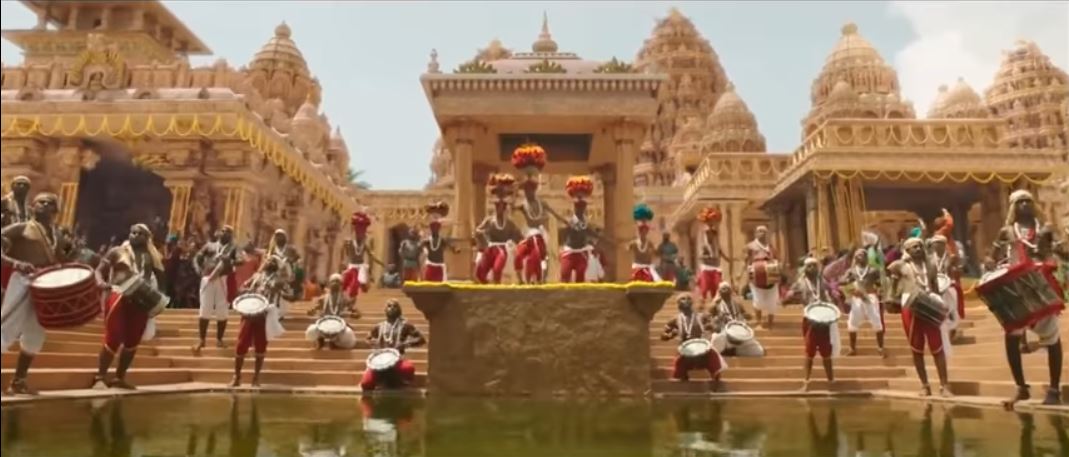
The no. 3 hit in Indian film history till 2015.
The money was spent on the most lavish sets and imaginative special effects in Indian history.
2016
2016 was the year of the small and medium budget film. Five of the seven most profitable films of the year were made on budgets of between Rs21 crore and Rs.40 crore.
Dangal, which created domestic box history, and Sultan, which was the year’s second highest grosser, were made on budgets of Rs.90 crore each, which is not as high as would be expected from Filmistan’s two top stars, Amir Khan and Salman Khan.
Mohenjo Daro and Shivaay, which had budgets of around Rs115 crore each, were both flops. (Source of budgets: Super Cinema )
According to Super Cinema Mohenjo Daro lost Rs60 crore and Shivaay Rs30 crore. (For details, and photographs, see Hindi-Urdu films: 2016.)
The city of Mohenjo Daro was recreated in great detail for the eponymous film. This cost money, as did some VFX.
Shivaay spent its budget on spectacular mountainscapes and on VFX, both in the mountains and in Bulgaria.
Box office rank that year
Shivaay (2h 49min) no.8
Mohenjo Daro (2h 35min) no.18
2017
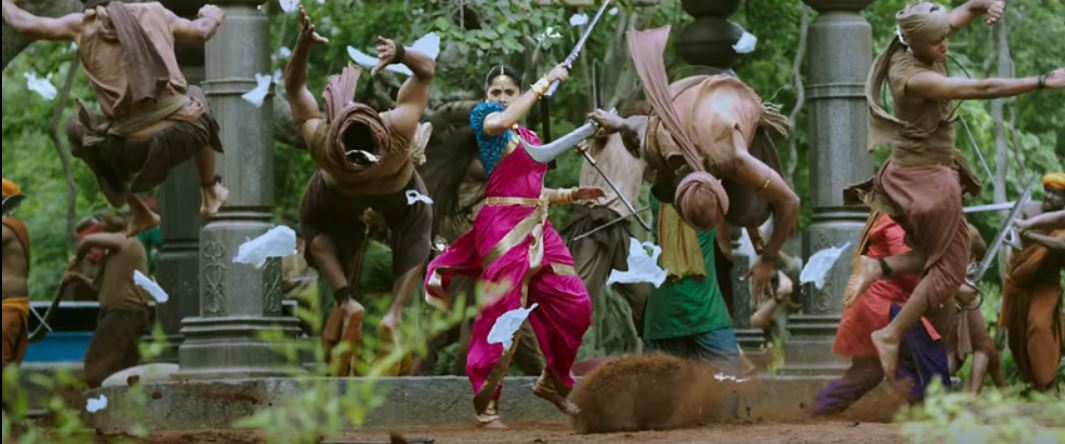
Scenes like this one, in which Anushka Shetty singe-handedly tosses several enemy soldiers into the air, drove up the film’s costs.
About the 2-part Bãhubali saga Forbes wrote in April 2017, ‘Both films were shot back-to-back for around $40m.’
The US dollar hovered around Rs.67 during this period. By the time Bahubali 2: The Conclusion (2017) was released the rupee had strengthened to Rs64.40 to the dollar. So, we are looking at a figure of between Rs.258 crore and Rs.268 crore. Together the 2-part Bãhubali saga is without doubt by far India's most expensive feature film ever. But if we divide the Forbes figure by two, then each part cost less that Bang Bang! did.
All the same, viewers of the Bãhubali films were looking at India’s biggest spectacle till then. The stunning kingdom of Mahishmati was common to both parts, as were many palace interiors. This effected economies of scale. But part 2 also had Devasena’s exquisite marble palace thrown in as an added attraction.
India Today had a different take. It wrote, ‘When it finally hits screens on April 28, Arka Mediaworks would have spent Rs 450 crore—Rs. 300 crore more than the earlier estimated budget for the two films.’
Bahubali 2: The Conclusion (2017) was India’s 3rd IMAX film and was released on 66 screens—India’s biggest IMAX release till then.
It was the most profitable and biggest earning film of 2017. (However, Dangal/ 摔跤吧!爸爸 , a film released in the last week of 2016, came up from behind, did record business in China and Taiwan, and earned more worldwide than Bahubali 2 both in absolute terms and in terms of return on investment. Bahubali 2 remains India’s no. 1 film at the domestic box office, though.)
2hr48m (168 minutes)
The budget of Tiger Zinda Hai, the year’s other big film, is generally accepted as Rs150 crore KoiMoi.com It was the second biggest box office hit of 2017 (i.e. in absolute terms), and the no.13 film most profitable of the year (i.e. in terms of return on investment).
2018
Padmaavat, the film, a period film and costume drama, cost around Rs.180 crore.(NDTV) It was released in 54 IMAX theatres in 3D, being the first Indian film in IMAX 3D. In addition to 12 IMAX theatres in India, it was also distributed to an 42 IMAX theatres in 10 markets outside of India, including North America, Australia, the Middle East, Africa and the UK.
Big budget flops
2007-17
The article archived below is about big-, not mega-, budget films and mostly covers the period 2007-17
10 Big budget Bollywood movies that didn’t do well at the box-office
It happens at times that in spite of budget, big stars, great script and an amazing team the film doesn’t do well at the box-office. Every year there are some movies that do well at the box office and there are some that do not work much at the box-office. Then there are bad movies that do really well at the box office too and there are movies too which are great but does not work at all at the box-office. Sometimes they are high-concept, and sometimes the movie is way ahead of its time that is the reasons why these movies are ignored, and sometimes even forgotten. It does happen at times that in spite of big stars the films don’t work. Sometimes the movies don’t work at the box-office but later it does well in Television and in other places. So here are 10 Bollywood films which had a big budget but failed to work at the box-office.
Bombay Velvet
It was a period crime drama film directed and co-produced by Anurag Kashyap, based on historian Gyan Prakash's book Mumbai Fables. It stars Ranbir Kapoor, Anushka Sharma and Karan Johar in lead roles with Kay Kay Menon, Manish Choudhary, Vivaan Shah and Siddhartha Basu appearing in supporting roles. The film, made on a budget of ₹120 crore but only took ₹22.27 crore. Set in 1960s Mumbai, the film tells the story of Balraj (Ranbir Kapoor), a street fighter/boxer who is in love with the jazz singer Rosie. Seeing Rosie (Anushka Sharma) with wealthy men further sparks his dream of becoming a "big-shot", believing that if he manages to become rich, he might win Rosie's heart. Balraj and his friend Chimman (Satyadeep Misra) then catch the eye of Kaizad Khambatta (Karan Johar), a wealthy businessman who is impressed by Balraj and offers him to manage his club "Bombay Velvet", which Khambatta uses to further his illegal tasks and activities. He also nicknames Balraj "Johnny", which then becomes his identification. As well as this, Johnny and Chimman fulfill minor tasks for Khambatta, including capturing a dirty photograph of a minister who Khambatta wants to blackmail. Khambatta shoots Rosie to provoke Johnny. Johnny angry at this stabs Khambatta and is himself shot dead while trying to carry Rosie to the hospital, outside the club. It is revealed at the start of the end credits that Rosie survives her gunshot.
Jab Harry Met Sejal
The romantic comedy film which stars badshah khan Shah Rukh Khan and Anushka Sharma didn’t do well at the box-office. It was directed by Imtiaz Ali. The film was made in 119 crores but it only collected 61 crores at the box office. The film received a generally negative response and did not perform well financially in India, though it did perform well overseas. The plot of the film was Harinder "Harry" Singh Nehra is a tourist guide in Amsterdam. He is shown to be a "cheap womaniser" as he calls himself a friendly and helpful guide. After dropping a family at the airport, Harry comes across Sejal Zaveri, a member of the same family, who has lost her engagement ring. He reluctantly agrees to help her find her ring. In due course of time, while searching for the ring, they become friends and he tells her that he had left his home in Nur Mahal village and came to Canada to become a singer, which did not work out and that is how he slowly became a tour guide. At the airport, Sejal shows Harry the ring and tells him that it was in her bag all along. He asks her to take care and bids her goodbye. She returns to India and he returns to his work but begins to miss Harry and gets depressed. On Mayank's insistence, Harry flies for Mumbai to go to her wedding. On reaching the venue, he learns that Sejals's marriage was called off. He walks out to find her sitting outside. They eventually share their feelings for each other and go to Harry's village, Nur Mahal, where he reunites with his family and marries Sejal.
Noor
Sonakshi Sinha’s film made on the budget of 22 crores just collected 7 crores from the box office. It was a comedy-drama film directed by Sunhil Sippy. The film is based on Pakistani author Saba Imtiaz's novel Karachi, ‘You're Killing Me!’ and follows an Indian journalist-writer Noor's misadventures and love life as she navigates her way through Mumbai. Noor is a journalist who works in a news agency. She is sent to take an interview with Sunny Leone, whom she resents. She loses her job over this after a tiff with Shekher (her boss). She has two friends - Saad and Zara. Saad has a restaurant in London while Zara is a DJ. Malti and Vilash go missing. Noor's father gets threat calls. He asks Saad to take Noor away for some time. Saad takes the sad and dellusioned Noor to London and gets frustrated by her state of mind and finally confronts her regarding the entire incident. Later he takes her out and he feels that he loves her. Noor gets a call from her father with the news that Vilash is dead. She comes back to Mumbai. Interviews many more people and finally the doctor is convicted. Noor becomes an internet sensation. Malti accepts her friend request on facebook. Zara slaps Ayan on her behalf. Saad in a roundabout manner kind of proposed her. Shekher acknowledges Noor's work and assigns her own office place. At the end, Noor was happy with everything.
Jagga Jasoos
The much-awaited film of Ranbir Kapoor and Katrina Kaif did not do well at the box-office. The budget of 131 crores was a huge flop as it only minted 53 crores at the box office. The film is a mystery comedy adventure film written and directed by Anurag Basu and produced by Anurag Basu and Ranbir Kapoor. It’s a story of a teenage detective in search of his missing father. The film was released on 14 July 2017. The film garnered ten nominations at the 63rd Filmfare Awards, winning four out of those. The story of Jagga Jasoos evolves around the infamous high profile case of Purulia Arms Drop, which took place in the year 1995 allegedly to overthrow the then Communist Government of West Bengal, India. Jagga (Ranbir Kapoor), a curious and shy young boy in a quaint little town lives a happy life with his accident-prone father, Bagchi (Saswata Chatterjee). After admitting Jagga into a boarding school, Bagchi suddenly disappears. Feeling abandoned, Jagga's only contact with Bagchi is a VHS tape that he receives in the mail every year on his birthday. Armed with sharp detective skills, Jagga sets out to solve the mystery of his missing parent. Along the way, he finds a partner in Shruti (Katrina Kaif), an accident-prone journalist with her own international criminal case to solve. Using a few tricks he learned from Bagchi, Jagga, with Shruti, embarks on a mission to uncover details of his father's mysterious life and finds himself embroiled in a worldwide smuggling racket.
Kites
The film was a Hindi/Spanish mix language dialogue romantic action thriller film directed by Anurag Basu, a story written and produced by Rakesh Roshan, starring Hrithik Roshan, Bárbara Mori, Kangana Ranaut, and Kabir Bedi. The film only managed to collect ₹48.56 crore but the budget of the film was ₹150 crores. Jai (Hrithik Roshan) is a dance teacher in Las Vegas, Nevada. As a sideline, he marries immigrant women to get them green cards in exchange for money. When Gina (Kangana Ranaut), the rich daughter of a powerful Anglo-Indian casino owner Bob (Kabir Bedi), falls for him, Jai goes along to marry into money. He discovers that his future brother-in-law, the vicious, homicidal Tony (Nicholas Brown), is about to marry a Mexican woman named Natasha (Bárbara Mori), whom Jai knows as Linda, the last of the immigrant women he married. On the night before "Natasha" and Tony's wedding, Linda and Jai spend a romantic but chaste night, humorously agreeing to a "divorce". Linda was ambushed on a cliff and sent Jai a text message saying "I am going...Sorry, Forget me". She drives off of the cliff, killing herself by drowning. Jai cries and then smiles, jumping off the cliff as well. Finally, he is reunited with Linda under the ocean, and they embrace through death.
OK Jaanu
Aditya Roy Kapur and Shraddha Kapoor who were seen together in ‘Aashiqui 2’ were also seen in ‘OK Jaanu’ once again. The film collected 23.60 crores at the box office. Although the film was made in the budget of 27 crores. The film stars Aditya Roy Kapur and Shraddha Kapoor in the lead roles, portraying a young couple in a live-in relationship in Mumbai with Naseeruddin Shah and Leela Samson play supporting roles as an older couple in the film, portraying the younger couple's landlords. Adi (Aditya Roy Kapur) is a video game developer who accidentally meets Tara (Shraddha Kapoor) at his friend's wedding. Tara is planning to pursue her studies in Paris, while Adi wants to achieve big in the United States as a video game developer and become a big shot like Mark Zuckerberg. They soon spend time together and fall in love. They agree that marriage is not for them and decide to have a live-in relationship instead, and Tara moves into Adi's place, rented from Gopi Srivastava (Naseeruddin Shah). They wish to spend their time with each other before they go their separate ways for their respective careers. Tara and Adi live happily, being playful with each other. Adi finally proposes to Tara and they decide to get married. Post marriage, both of them continue to accomplish their own dreams, one in Paris, another in the United States, keeping in touch and waiting for the day they can be together again.
Raavan
It was a Hindi epic adventure film co-written, co-produced, and directed by Mani Ratnam. It stars Abhishek Bachchan, Aishwarya Rai, and Vikram in the lead roles. Govinda, Ravi Kishan, Nikhil Dwivedi, Tejaswini Kolhapure, Ajay Gehi and Priyamani feature in key supporting roles. This film was the Bollywood debut of Tamil Superstar Vikram. It was simultaneously released in Tamil as Raavanan with a slightly different cast, which was also dubbed into Telugu and other regional languages. The budge of the film was 300 million but it only made 4.5 million. Beera Munda, a bandit, jumps off a cliff into the water. His gang distracts the police and police vehicles are set on fire. Ragini Sharma, on a boating trip, is kidnapped by Beera. Dev Pratap Sharma, her husband and a superintendent of police, is informed of her abduction. Ragini refuses to die at the bandit's hands and jumps off the cliff, but survives and Beera holds off her killing, as he sees it useless to kill someone who has no fear of death. While on their way home, Dev accuses Ragini of infidelity and claims it was Beera who told him of it. Infuriated, Ragini leaves Dev to meet Beera through Mangal. They, however, realize Dev lied, hoping Ragini would lead him to his hideout. Dev appears with a police team and confronts the duo, reminding Beera of his vow. Ragini stands in front of Beera to save him, but Beera pushes her out of the line of fire and is shot multiple times. Ragini's true feelings surface when she tries to save Beera with all her might. Content that she too has feelings for him, Beera falls off the cliff to his death with a smile.
The Saif Ali Khan, Shahid Kapoor and Kangana Ranaut film earning of 21 crores. The film was made in the budget of 80 crores. It was an Indian period war drama film, directed by Vishal Bhardwaj. The project is a period film set during World War II (1939–1945) with the leading actress supposedly playing a character based on the life and times of Mary Ann Evans aka Fearless Nadia, Bollywood’s first original stunt-woman still remembered for her fiery role in the movie Hunterwali. In 1943, as the Second World War rages on, India is fighting a combat of her own: independence from British rule. Subash Chandra Bose, the founder of the Indian National Army, has become disenchanted with Mahatma Gandhi's Ahimsa (non-violent) movement and desires to fight fire with fire. Recognizing the growing dominance of Imperial Japanese Army in the Indo-China region, the INA allies itself with the Japanese, hoping to ride the wave to Delhi. Indian troops in the British Indian Army are locked in pitched battles with both the INA and its Japanese contingent. In one such skirmish close to the Indo-Burma border, Jemadar Nawab Malik (Shahid Kapoor) and a group of fellow soldiers are cornered by the Japanese infantry. Running to escape on a barge, he is shot and captured as a prisoner of war. Meanwhile, the INA's top brass desperately seeks finances to replenish its heavy ammunition to aid the charge to Delhi. Billimoria asks Julia for her last wish, who appeals that he continues her task of delivering the sword to the INA before falling to her death. Unsheathing the shining sword, Billimoria massacres the rest of the British troops on the bridge, decapitates Harding, and delivers the sword to the INA. The film ends by proclaiming the INA raised the Indian flag in 1944.
Meri Pyaari Bindu
It is an Indian Hindi romantic drama film, written by Suprotim Sengupta and directed by Akshay Roy. It features Ayushmann Khurrana and Parineeti Chopra in the lead roles. It was made in the budget of 22 crores, collected 10 crores. The film revolves around Abhimanyu Roy (Ayushmann Khurrana) and Bindu Shankarnarayanan (Parineeti Chopra) are best friends since childhood. Abhimanyu has always been in love with Bindu much to his mother's dismay. He never conveys his real feelings to Bindu and is happy being just friends with her. One day, Bindu's mother (June Malia) dies in an accident. Heartbroken Bindu blames her father as he was driving the car while drunk. Her growing resentment towards her father forces her to leave college and go to Melbourne. Now Abhimanyu becomes a writer who writes erotic horror novels, his first novel becomes a hit. But the manager forces him to write novels quickly. Thus he takes a break and moves to his house in Kolkata. A birthday party is organised and Bindu comes to Kolkata as well. Bindu is now married to someone else and has a daughter as well. Both of them visit the place where they used to go to since they were children and start remembering their past memories. The film ends as Abhimanyu and Bindu dance together at a birthday party.
Saawariya
It was a romantic film produced and directed by Sanjay Leela Bhansali. The film is based on Fyodor Dostoevsky's short story ‘White Nights’. The film marks the debut of both the lead actors; Ranbir Kapoor son of actors Rishi Kapoor and Neetu Singh, and Sonam Kapoor, daughter of actor Anil Kapoor. It was made with a budget of 45 crores but it only made 39 crores. The story is narrated by Gulabji (Rani Mukherjee), a prostitute who frequents RK Bar, the town's most luxurious club. The bar's lead singer, Raj (Ranbir Kapoor), whom she affectionately calls "Saawariya" ("blue lover"), is a free-spirited and kindhearted man. Despite knowing what Gulabji does, Raj is friendly to her, and unlike other men, is kind to the other prostitutes, trying to brighten their sad lives. When he tells Gulabji that he needs a job and somewhere to stay, she tells him that there is only one woman who'll give him a place to stay: Lilian (Zohra Sehgal) – but she allows only those she likes. Raj tries to make Sakina happy and succeeds. When they are returning home, they pass the bridge where they first met and see Imaan waiting for Sakina. Sakina hesitates as she steps toward Raj. Raj, however, tells her to go and Sakina reunites with Imaan. The movie ends as a tribute to Raj Kapoor, where Raj walks and sings in a style similar to Kapoor from the film Shree 420, remembering the sweet moments he spent with Sakina.
See also
Box office records of Hindi-Urdu films
Records for the 1930s are non-existent but you may still want to see
Hindi-Urdu films: 1931 <> Hindi-Urdu films: 1932 <> Hindi-Urdu films: 1938 <> Hindi-Urdu films: 1939 <>
The highest grossing films of Individual years (and some decades) are listed at:
Hindi-Urdu films: 1940 <> Hindi-Urdu films: 1941 <> Hindi-Urdu films: 1942 <> Hindi-Urdu films: 1943 <> Hindi-Urdu films: 1944 <> Hindi-Urdu films: 1945 <> Hindi-Urdu films: 1946 <> Hindi-Urdu films: 1947 <> Hindi-Urdu films: 1948 <> Hindi-Urdu films: 1949 <> The Hits of the 1940s<> Hindi-Urdu films: 1950 <> Hindi-Urdu films: 1951 <> Hindi-Urdu films: 1952 <> Hindi-Urdu films: 1953 <> Hindi-Urdu films: 1954 <> Hindi-Urdu films: 1955 <> Hindi-Urdu films: 1956 <> Hindi-Urdu films: 1957 <> Hindi-Urdu films: 1958 <> Hindi-Urdu films: 1959 <> The Hits of the 1950s<> Hindi-Urdu films: 1960 <> Hindi-Urdu films: 1961 <> Hindi-Urdu films: 1962 <> Hindi-Urdu films: 1963 <> Hindi-Urdu films: 1964 <> Hindi-Urdu films: 1965 <> Hindi-Urdu films: 1966 <> Hindi-Urdu films: 1967 <> Hindi-Urdu films: 1968 <> Hindi-Urdu films: 1969 <> Hindi-Urdu films: 1970 <> Hindi-Urdu films: 1971 <> Hindi-Urdu films: 1972 <> Hindi-Urdu films: 1973 <> Hindi-Urdu films: 1974 <> Hindi-Urdu films: 1975 <> Hindi-Urdu films: 1976 <> Hindi-Urdu films: 1977 <> Hindi-Urdu films: 1978 <> Hindi-Urdu films: 1979 <> Hindi-Urdu films: 1980 <> Hindi-Urdu films: 1981 <> Hindi-Urdu films: 1982 <> Hindi-Urdu films: 1983 <> Hindi-Urdu films: 1984 <> Hindi-Urdu films: 1985 <> Hindi-Urdu films: 1986 <> Hindi-Urdu films: 1987 <> Hindi-Urdu films: 1988 <> Hindi-Urdu films: 1989 <> Hindi-Urdu cinema: 1980-89 <> Hindi-Urdu films: 1990 <> Hindi-Urdu films: 1991 <> Hindi-Urdu films: 1992 <> Hindi-Urdu films: 1993 <> Hindi-Urdu films: 1994 <> Hindi-Urdu films: 1995 <> Hindi-Urdu films: 1996 <> Hindi-Urdu films: 1997 <> Hindi-Urdu films: 1998 <> Hindi-Urdu films: 1999 <> The Hits of the 1990s<> Hindi-Urdu films: 2000 <> Hindi-Urdu films: 2001 <> Hindi-Urdu films: 2002 <> Hindi-Urdu films: 2003 <> Hindi-Urdu films: 2004 <> Hindi-Urdu films: 2005 <> Hindi-Urdu films: 2006 <> Hindi-Urdu films: 2007 <> Hindi-Urdu films: 2008 <> Hindi-Urdu films: 2009 <> Hindi-Urdu films: 2010 <> Hindi-Urdu films: 2011 <> Hindi-Urdu films: 2012 <> Hindi-Urdu films: 2013 <> Hindi-Urdu films: 2014 <> Hindi-Urdu films: 2015 <> Hindi-Urdu films: 2016 <> Hindi-Urdu films: 2017...
And also
Box office records of Malayalam films 1980-2016, quite detailed
There are less detailed but evolving pages dedicated to
